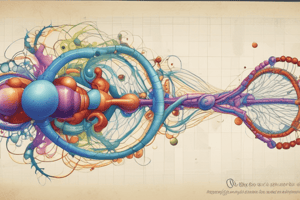Podcast
Questions and Answers
What are the base pair rules in RNA?
What are the base pair rules in RNA?
A-U and C-G
Which type of RNA carries information from DNA to the ribosome?
Which type of RNA carries information from DNA to the ribosome?
- transfer RNA (tRNA)
- messenger RNA (mRNA) (correct)
- RNAi
- ribosomal RNA (rRNA)
In mRNA editing, introns are ________ (cut out).
In mRNA editing, introns are ________ (cut out).
excised
Mutations refer to any change in DNA sequence.
Mutations refer to any change in DNA sequence.
What is the function of the nervous system?
What is the function of the nervous system?
Which type of cells lack membrane-bound organelles such as a nucleus?
Which type of cells lack membrane-bound organelles such as a nucleus?
What organelle in a cell holds DNA and the nucleolus?
What organelle in a cell holds DNA and the nucleolus?
Mitochondria is the site of cellular respiration where glucose is broken down to produce ATP.
Mitochondria is the site of cellular respiration where glucose is broken down to produce ATP.
The _______________ complex is responsible for packaging in membrane and signaling for export.
The _______________ complex is responsible for packaging in membrane and signaling for export.
Match the following cell organelles with their functions:
Match the following cell organelles with their functions:
Flashcards are hidden until you start studying
Study Notes
Cell Structure and Function
- Cells are the basic units of life, with two main types: prokaryotic (bacteria) and eukaryotic (all other living things)
- Prokaryotic cells lack membrane-bound organelles, have a single circular DNA molecule, and free ribosomes and a cell wall
- Eukaryotic cells have membrane-bound organelles, multiple linear DNA molecules, and histones on DNA
Cell Organelles
- Nucleus: holds DNA and nucleolus, where ribosomal subunits are made
- Mitochondria: double membrane, site of cellular respiration, outer membrane is smooth, and inner membrane is folded with enzymes
- Ribosome: site of translation, protein synthesis, made of rRNA and protein
- Endoplasmic Reticulum (ER): connected to nucleus, allows for reactions, membranous, smooth ER for lipids, and rough ER for proteins
- Golgi Complex: packaging in membrane and signals for export
- Cytoskeleton: microfilaments, microtubules, and centrioles; gives shape, movement, and support to the cell
- Vacuoles/Vesicles: storage of water and solutes
Cell Membrane
- Phospholipid bilayer: selectively permeable, amphipathic
- Fluid Mosaic Model: in motion, proteins, cholesterol, glycoproteins, and glycolipids among phospholipids
- Types of transport: simple diffusion, facilitated diffusion, active transport, endocytosis, and exocytosis
- Osmosis: diffusion of water using a selectively permeable membrane
Energy and Metabolism
- Energy: free energy is used for organization, growth, and reproduction
- First law of thermodynamics: energy is not created or destroyed, only converted
- Second law of thermodynamics: entropy increases, organization decreases
- Cellular Respiration: breaks down glucose, produces ATP, occurs in mitochondria, and involves glycolysis, Krebs cycle, and electron transport chain
- Photosynthesis: captures free energy, uses water and carbon dioxide, produces glucose and oxygen, and occurs in chloroplasts
Cell Cycle
- Cell cycle: interphase, cell division, and cytokinesis
- Interphase: growth, synthesis of DNA, and preparation for mitosis
- Mitosis: duplicated chromosomes line up, spindle fibers pull them apart, and cytokinesis divides cytoplasm and reforms cell membrane
- Checkpoints: internal controls, external signals, and DNA damage
Molecular Genetics
- DNA structure: double helix, nucleotides, phosphate, sugar, nitrogen base, and antiparallel strands
- DNA replication: semi-conservative, bidirectional, and involves helicase, DNA polymerase, and ligase
- RNA: single stranded, ribose sugar, uracil instead of thymine, and base pair rules
- Transcription: making mRNA, involves RNA polymerase, and occurs in the nucleus
- mRNA editing: introns are excised, exons are spliced together, and a polyA tail and GTP cap are added
- Translation: mRNA code is read, matched with tRNA, and constructs a polypeptide using the ribosome
Mutations
- Any change in the DNA sequence, can be inheritable if in egg or sperm
- Point mutations: one nucleotide error, substitutions, insertions, or deletions
- Frame shift mutations: one or more bases deleted or inserted
- Silent mutations: substitution codes for the same amino acid or deletion/insertion is of three nucleotides
Studying That Suits You
Use AI to generate personalized quizzes and flashcards to suit your learning preferences.




